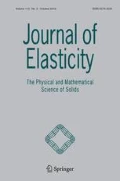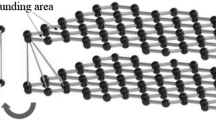Abstract
Graphene sheets can be considered as lattices consisting of atoms and of interatomic bonds. Their bond lengths are smaller than one nanometer. Simple models describe their behavior by an energy that takes into account both the interatomic lengths and the angles between bonds. We make use of their periodic structure and we construct an equivalent macroscopic model by means of a discrete homogenization technique. Large three-dimensional deformations of graphene sheets are thus governed by a membrane model whose constitutive law is implicit. By linearizing around a prestressed configuration, we obtain linear membrane models that are valid for small displacements and whose constitutive laws are explicit. When restricting to two-dimensional deformations, we can linearize around a rest configuration and we provide explicit macroscopical mechanical constants expressed in terms of the interatomic tension and bending stiffnesses.
Similar content being viewed by others
References
N.L. Allinger, Y.H. Yuh and J.H. Lii, Molecular mechanics. The MM3 force field for hydrocarbons. J. Am. Chem. Soc. 111 (1989) 8551–8566.
S.S. Antman, Nonlinear Problems of Elasticity. Springer, Berlin Heidelberg New York (1995).
A. Bensoussan, J.-L. Lions and G. Papanicolaou, Asymptotic Analysis for Periodic Stuctures. North-Holland, Amsterdam (1978).
X. Blanc, C. Le Bris and P.-L. Lions, From molecular models to continuum mechanics. Arch. Ration. Mech. Anal. 164 (2002) 341–381.
A. Braides and M.S. Gelli, The passage from discrete to continuous variational problems: A nonlinear homogenization process. In: P. Ponte Castaneda (ed.), Nonlinear Homogenization and its Applications to Composites, Polycrystals and Smart Materials. Kluwer (2004) pp. 45–63.
D.W. Brenner, Empirical potential for hydrocarbons for use in simulating the chemical vapor deposition of diamond films. Phys. Rev., B 42 (1990) 9458–9471.
D. Caillerie, A. Mourad and A. Raoult, Cell-to-muscle homogenization. Application to a constitutive law for the myocardium. M2AN Modél. Math. Anal. Numér. 37 (2003) 681–698.
C.F. Cornwell and L.T. Wille, Elastic properties of single-walled carbon nanotubes in compression. Solid State Commun. 101 (1997) 555–558.
D. Coutand, Théorèmes d'existence pour un modèle membranaire proprement invariant de plaque non linéairement élastique. C. R. Acad. Sci., Sér. 1 Paris 324 (1997) 1181–1184.
D. Fox, A. Raoult and J.C. Simo, A justification of nonlinear properly invariant plate theories. Arch. Ration. Mech. Anal. 124 (1993) 157–199.
M.E. Gurtin, An Introduction to Continuum Mechanics. Academic, New York (1981).
A. Krishnan, E. Dujardin, E. Ebbesen, P.N. Yianilos and M.M.J. Treacy, Young's modulus of single-walled nanotubes. Phys. Rev., B 58 (1998) 14013–14019.
T. Lenosky, X. Gonze, M. Teter and V. Elser, Energetics of negatively curved graphitic carbon. Nature 355 (1992) 333–335.
J.Z. Liu, Q. Zheng and Q. Jiang, Effect of a rippling mode on resonances of carbon nanotubes. Phys. Rev. Lett. 86 (2001) 4843–4846.
C.-S. Man and D.E. Carlson, On the traction problem of dead loading in linear elasticity with initial stress. Arch. Ration. Mech. Anal. 128 (1994) 223–247.
A. Mourad, Description topologique de l'architecture fibreuse et modélisation mécanique du myocarde. Doctoral Dissertation, Institut National Polytechnique de Grenoble, Grenoble, France (2003).
G. Odegard, T.S. Gates, L. Nicholson and C. Wise, Equivalent continuum modeling of nanostructured materials. NASA Technical Report, NASA TM-2001–210863 (2001).
D.H. Robertson, D.W. Brenner and J.W. Mintmire, Energetics of nanoscale graphitic tubules. Phys. Rev., B 45 (1992) 12592–12595.
E. Sanchez-Palencia, Non Homogeneous Media and Vibration Theory. Monographs in Physics, 127, Springer, Berlin Heidelberg New York (1980).
J. Tersoff, New empirical approach for the structure and energy of covalent systems. Phys. Rev., B 37 (1988) 6991–7000.
H. Tollenaere and D. Caillerie, Continuous modeling of lattice structures by homogenization. Adv. Eng. Softw. 29 (1998) 699–705.
M.M.J. Treacy, T.W. Ebbesen and J.M. Gibson, Exceptionally high Young's modulus observed for individual carbon nanotubes. Nature 381 (1996) 678–680.
Z. Tu and Z. Ou-Yang, Single-walled and multiwalled carbon nanotubes viewed as elastic tubes with the effective Young's moduli dependent on layer number. Phys. Rev., B 65 (2002) 233407–233410.
E.W. Wong, P.E. Sheehan and C.M. Lieber, Nanobeam mechanics: Elasticity, strength, and toughness of nanorods and nanotubes. Science 277 (1997) 1971–1975.
B.I. Yakobson, C.J. Brabec and J. Bernholc, Nanomechanics of carbon tubes: Instabilities beyond linear response. Phys. Rev. Lett. 76 (1996) 2511–2514.
M.F. Yu, B.S. Files, S. Arepalli and R.S. Ruoff, Tensile loading of ropes of single wall carbon nanotubes and their mechanical properties. Phys. Rev. Lett. 84 (2000) 5552–5555.
M.F. Yu, O. Lourie, M.J. Dyer, K. Moloni, T.F. Kelly and R.S. Ruoff, Strength and breaking mechanism of multiwalled carbon nanotubes under tensile load. Science 287 (2000) 637–640.
X. Zhou, J. Zhou and Z. Ou-Yang, Strain energy and Young's modulus of single-wall carbon nanotubes calculated from electronic energy-band theory. Phys. Rev., B 62 (2000) 13692–13696.
G. Zhou, W. Duan and B. Gu, First-principles study on morphology and mechanical properties of single-walled carbon nanotube. Chem. Phys. Lett. 333 (2001) 344–349.
Author information
Authors and Affiliations
Corresponding author
Rights and permissions
About this article
Cite this article
Caillerie, D., Mourad, A. & Raoult, A. Discrete Homogenization in Graphene Sheet Modeling. J Elasticity 84, 33–68 (2006). https://doi.org/10.1007/s10659-006-9053-5
Received:
Accepted:
Published:
Issue Date:
DOI: https://doi.org/10.1007/s10659-006-9053-5



